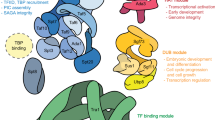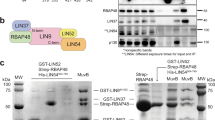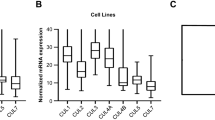Abstract
Switches between different phenotypes and their underlying states of gene transcription occur as cells respond to intrinsic developmental cues or adapt to changing environmental conditions. Post-translational modification of the master regulatory transcription factors that define the initial phenotype is a common strategy to direct such transitions. Emerging evidence indicates that the modification of key transcription factors by the small polypeptide ubiquitin has a central role in many of these transitions1,2. However, the molecular mechanisms by which ubiquitylation regulates the switching of promoters between active and inactive states are largely unknown. Ubiquitylation of the yeast transcriptional repressor α2 is necessary to evoke the transition between mating-types3, and here we dissect the impact of this modification on α2 dynamics at its target promoters. Ubiquitylation of α2 does not alter DNA occupancy by depleting the existing pool of the transcription factor, despite its well-characterized function in directing repressor turnover. Rather, α2 ubiquitylation has a direct role in the rapid removal of the repressor from its DNA targets. This disassembly of α2 from DNA depends on the ubiquitin-selective AAA-ATPase Cdc48. Our findings expand the functional targets of Cdc48 to include active transcriptional regulatory complexes in the nucleus. These data reveal an ubiquitin-dependent extraction pathway for dismantling transcription factor–DNA complexes and provide an archetype for the regulation of transcriptional switching events by ubiquitylation.
This is a preview of subscription content, access via your institution
Access options
Subscribe to this journal
Receive 12 print issues and online access
$209.00 per year
only $17.42 per issue
Buy this article
- Purchase on Springer Link
- Instant access to full article PDF
Prices may be subject to local taxes which are calculated during checkout





Similar content being viewed by others
References
Dennis, A. P. & O'Malley, B. W. Rush hour at the promoter: how the ubiquitin-proteasome pathway polices the traffic flow of nuclear receptor-dependent transcription. J. Steroid Biochem. Mol. Biol. 93, 139–151 (2005).
Collins, G. A. & Tansey, W. P. The proteasome: a utility tool for transcription? Curr. Opin. Genet. Dev. 16, 197–202 (2006).
Laney, J. D. & Hochstrasser, M. Ubiquitin-dependent degradation of the yeast Matα2 repressor enables a switch in developmental state. Genes Dev. 17, 2259–2270 (2003).
Herskowitz, I. A regulatory hierarchy for cell specialization in yeast. Nature 342, 749–757 (1989).
Nasmyth, K. & Shore, D. Transcriptional regulation in the yeast life cycle. Science 237, 1162–1170 (1987).
Hochstrasser, M. & Varshavsky, A. In vivo degradation of a transcriptional regulator: the yeast α2 repressor. Cell 61, 697–708 (1990).
Chen, P., Johnson, P., Sommer, T., Jentsch, S. & Hochstrasser, M. Multiple ubiquitin-conjugating enzymes participate in the in vivo degradation of the yeast MATα2 repressor. Cell 74, 357–369 (1993).
Swanson, R., Locher, M. & Hochstrasser, M. A conserved ubiquitin ligase of the nuclear envelope/endoplasmic reticulum that functions in both ER-associated and Matalpha2 repressor degradation. Genes Dev. 15, 2660–2674 (2001).
Richter-Ruoff, B., Wolf, D. H. & Hochstrasser, M. Degradation of the yeast MATα2 transcriptional regulator is mediated by the proteasome. FEBS Lett. 354, 50–52 (1994).
Hochstrasser, M., Ellison, M. J., Chau, V. & Varshavsky, A. The short-lived MATα2 transcriptional regulator is ubiquitinated in vivo. Proc. Natl. Acad. Sci. USA. 88, 4606–4610 (1991).
McNally, J. G., Muller, W. G., Walker, D., Wolford, R. & Hager, G. L. The glucocorticoid receptor: rapid exchange with regulatory sites in living cells. Science 287, 1262–1265 (2000).
Stenoien, D. L. et al. Ligand-mediated assembly and real-time cellular dynamics of estrogen receptor alpha-coactivator complexes in living cells. Mol. Cell Biol. 21, 4404–4412 (2001).
Cheutin, T. et al. Maintenance of stable heterochromatin domains by dynamic HP1 binding. Science 299, 721–725 (2003).
Karpova, T. S. et al. Concurrent fast and slow cycling of a transcriptional activator at an endogenous promoter. Science 319, 466–469 (2008).
Keleher, C. A., Goutte, C. & Johnson, A. D. The yeast cell-type-specific repressor alpha 2 acts cooperatively with a non-cell-type-specific protein. Cell 53, 927–936 (1988).
Smith, D. L. & Johnson, A. D. A molecular mechanism for combinatorial control in yeast: MCM1 protein sets the spacing and orientation of the homeodomains of an alpha 2 dimer. Cell 68, 133–142 (1992).
Vershon, A. K. & Johnson, A. D. A short, disordered protein region mediates interactions between the homeodomain of the yeast alpha 2 protein and the MCM1 protein. Cell 72, 105–112 (1993).
Vershon, A. K., Jin, Y. & Johnson, A. D. A homeo domain protein lacking specific side chains of helix 3 can still bind DNA and direct transcriptional repression. Genes Dev. 9, 182–192 (1995).
Zhong, H. & Vershon, A. K. The yeast homeodomain protein MATalpha2 shows extended DNA binding specificity in complex with Mcm1. J. Biol. Chem. 272, 8402–8409 (1997).
Zhong, H., McCord, R. & Vershon, A. K. Identification of target sites of the alpha2-Mcm1 repressor complex in the yeast genome. Genome Res. 9, 1040–1047 (1999).
Ganter, B., Tan, S. & Richmond, T. J. Genomic footprinting of the promoter regions of STE2 and STE3 genes in the yeast Saccharomyces cerevisiae. J. Mol. Biol. 234, 975–987 (1993).
Freeman, B. C. & Yamamoto, K. R. Disassembly of transcriptional regulatory complexes by molecular chaperones. Science 296, 2232–2235 (2002).
Acharya, U. et al. The formation of Golgi stacks from vesiculated Golgi membranes requires two distinct fusion events. Cell 82, 895–904 (1995).
Ghislain, M., Dohmen, R. J., Levy, F. & Varshavsky, A. Cdc48p interacts with Ufd3p, a WD repeat protein required for ubiquitin-mediated proteolysis in Saccharomyces cerevisiae. EMBO J. 15, 4884–4899 (1996).
Hetzer, M. et al. Distinct AAA-ATPase p97 complexes function in discrete steps of nuclear assembly. Nature Cell Biol. 3, 1086–1091 (2001).
Rabouille, C., Levine, T. P., Peters, J. M. & Warren, G. An NSF-like ATPase, p97, and NSF mediate cisternal regrowth from mitotic Golgi fragments. Cell 82, 905–914 (1995).
Ye, Y., Meyer, H. H. & Rapoport, T. A. The AAA ATPase Cdc48/p97 and its partners transport proteins from the ER into the cytosol. Nature 414, 652–656 (2001).
Rape, M. et al. Mobilization of processed, membrane-tethered SPT23 transcription factor by CDC48(UFD1/NPL4), a ubiquitin-selective chaperone. Cell 107, 667–677 (2001).
Ramadan, K. et al. Cdc48/p97 promotes reformation of the nucleus by extracting the kinase Aurora B from chromatin. Nature 450, 1258–1262 (2007).
Ye, Y. Diverse functions with a common regulator: ubiquitin takes command of an AAA ATPase. J. Struct. Biol. 156, 29–40 (2006).
Robzyk, K., Recht, J. & Osley, M. A. Rad6-dependent ubiquitination of histone H2B in yeast. Science 287, 501–504 (2000).
Xie, Y. et al. The yeast Hex3.Slx8 heterodimer is a ubiquitin ligase stimulated by substrate sumoylation. J. Biol. Chem. 282, 34176–34184 (2007).
Deshaies, R. J. The self-destructive personality of a cell cycle in transition. Curr. Opin. Cell Biol. 7, 781–789 (1995).
DeRenzo, C. & Seydoux, G. A clean start: degradation of maternal proteins at the oocyte-to-embryo transition. Trends Cell Biol. 14, 420–426 (2004).
Mumberg, D., Muller, R. & Funk, M. Regulatable promoters of Saccharomyces cerevisiae: comparison of transcriptional activity and their use for heterologous expression. Nucleic Acids Res. 22, 5767–5768 (1994).
Mumberg, D., Muller, R. & Funk, M. Yeast vectors for the controlled expression of heterologous proteins in different genetic backgrounds. Gene 156, 119–122 (1995).
Strahl-Bolsinger, S., Hecht, A., Luo, K., and Grunstein, M. SIR2 and SIR4 interactions differ in core and extended telomeric heterochromatin in yeast. Genes Dev. 11, 83–93 (1997).
Gregory, P.D., Barbaric, S. & Horz, W. Analyzing chromatin structure and transcription factor binding in yeast. Methods 15, 295–302 (1998).
Mead, J., Zhong, H., Acton, T.B. & Vershon, A.K. The yeast α2 and Mcm1 proteins interact through a region similar to a motif found in homeodomain proteins of higher eukaryotes. Mol. Cell. Biol. 16, 2135–2143 (1996).
Jorgensen, P. et al. The size of the nucleus increases as yeast cells grow. Mol. Biol. Cell 18, 3523–3532 (2007).
Acknowledgements
We are grateful to Y. Xie and M. Hochstrasser for sharing data and reagents in advance of publication, for providing strains and plasmids and for many discussions. We thank R. Hampton and S. Jentsch for providing strains, R. Whitaker and R. Reenan for the sequencing of cdc48 alleles, J. Mead and D. Vershon for the His-tagged α2 construct, S. Gregory and A. Dahlberg for their help with the footprinting experiments, and T. Serio for numerous discussions. Our ideas were also shaped by discussions with K. Wilkinson and R. Deshaies. The manuscript was improved by comments from T. Serio, J. Bender, Y. Xie, M. Hochstrasser, R. Reenan and A. DeSimone. This work was supported by a grant from the National Institutes of Health (GM71764 to J.D.L.) and by a Basil O'Connor Starter Scholar Research Award from the March of Dimes.
Author information
Authors and Affiliations
Contributions
A.J.W. performed all of the experiments. A.J.W. and J.D.L. conceived and designed the experiments, analysed the results and prepared the manuscript.
Corresponding author
Ethics declarations
Competing interests
The authors declare no competing financial interests.
Supplementary information
Supplementary Information
Supplementary Information (PDF 475 kb)
Rights and permissions
About this article
Cite this article
Wilcox, A., Laney, J. A ubiquitin-selective AAA-ATPase mediates transcriptional switching by remodelling a repressor–promoter DNA complex. Nat Cell Biol 11, 1481–1486 (2009). https://doi.org/10.1038/ncb1997
Received:
Accepted:
Published:
Issue Date:
DOI: https://doi.org/10.1038/ncb1997
This article is cited by
-
ASPSCR1-TFE3 reprograms transcription by organizing enhancer loops around hexameric VCP/p97
Nature Communications (2024)
-
The ubiquitin-dependent ATPase p97 removes cytotoxic trapped PARP1 from chromatin
Nature Cell Biology (2022)
-
Regulation of transcriptional activators by DNA-binding domain ubiquitination
Cell Death & Differentiation (2017)
-
Immunoreactivity of valosin-containing protein in sporadic amyotrophic lateral sclerosis and in a case of its novel mutant
Acta Neuropathologica Communications (2014)
-
DNA damage emergency: cellular garbage disposal to the rescue?
Oncogene (2014)



